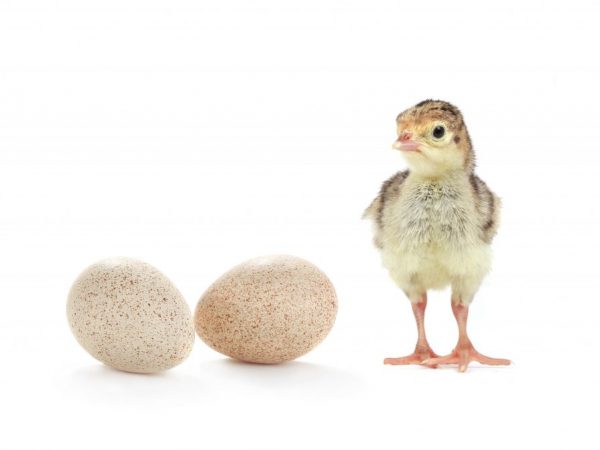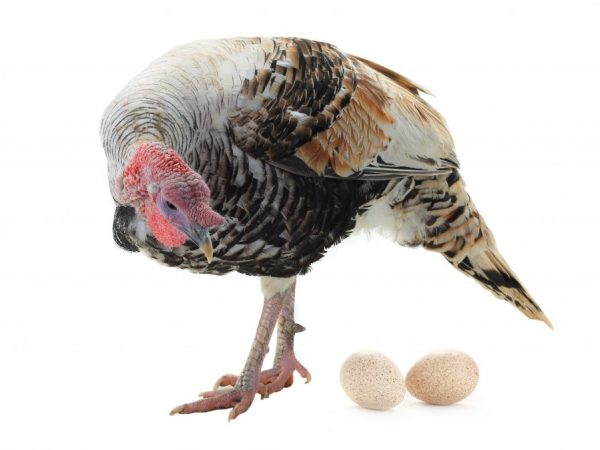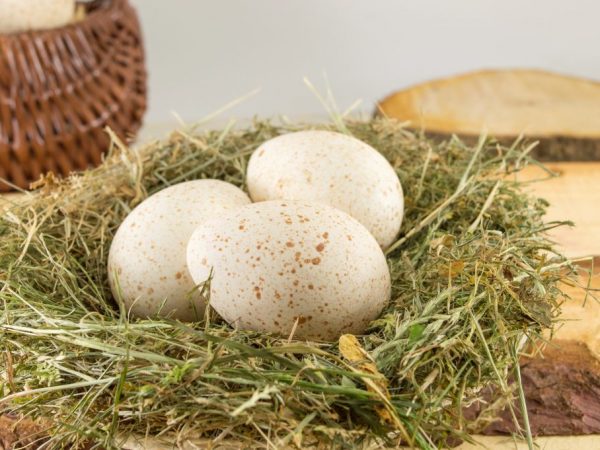When the turkeys start to rush
Poultry farming is an affordable and inexpensive option for getting fresh produce at home. Lack of information from inexperienced farmers can worsen the performance of even the most undemanding breed. When do turkeys start laying? Let's analyze the important physiological aspects of the species.

Suitable age for laying turkeys
Bird features
Unlike chickens, a turkey is very moody and demanding birdtherefore, not every breeder will be able to achieve maximum productivity. Knowing how to observe animals, you can accurately plan egg production and hatching young animals. At what age and how does this important process take place?
Depending on the breed, turkeys enter the time of maturity at 7-8 months of age, although there are examples when they rushed 150 days old. Professionals argue that early egg production does not mean good product quality. Most often, such specimens are very small and with various defects.
No matter how much the process begins, its activity depends on the physiological lines of the species. Broiler breeds do not lay earlier than layers. By the way, early maturity is an inherited factor.
The quality of the product is often influenced by the temperature and light conditions in the room. Lack of heat and light slows down the bird's internal clock. Optimally selected conditions will allow you to accelerate fertility without any problems. However, a sharp increase in the day and the permissible degree will negatively affect the physiological characteristics of the young.
When do turkeys start laying at home? The process coincides with the calendar spring - March and mid-April. By this period, the body has already matured and is fully ready for performance. With each season, the birds produce fewer eggs, so after three years it is recommended to change the laying hens.
Reproductiveness
The homeland of the species is America, the first representatives were brought to Europe by the Spaniards. Large birds have taken root at home and delight their owners with delicious, dietary meat... How often and how many eggs does the turkey lay?
Depending on the breed, each female in one breeding season brings from 75 to 125 pieces, although there are species that give 200 copies. The product is covered with a creamy white shell with small dots and weighs approximately 80-90 grams. The younger the "lady", the lighter the protective layer.
In the spring and late autumn, turkeys produce 1 egg each over a period of one or two days. If the farmer complies with all the requirements for keeping, then the birds consistently give a specimen per day. It should be remembered that the species does not have year-round production.
To ensure high-quality fertilization of products, it is necessary to think over the ratio of heads. One turkey is needed for every ten females. Mating occurs up to three times a week. Since males are much larger and more aggressive than young ladies, the process must go without injuries: before the mating season, the boy is recommended to shorten his nails.
How many days are females ready to hatch? When turkeys begin to lay eggs actively, it is a sign of motherhood. A tender bird will react painfully to extraneous sounds and noises. We advise you not to disturb the "lady" on trifles and do not look into the nest while she is sitting in it.
Signs of imminent productivity

The behavior of birds will tell you about the approaching mating season.
An attentive owner is obliged to keep the livestock in excellent conditions. Before an increasing clutch, the bird radically changes its behavior, so you can quickly identify the laying hen.
- Retires. If the "young lady" is looking for a quiet place, then this is an important sign that the natural process is close.
- Arrangement of the nest... If the turkeys begin to rush, then the space is preliminarily prepared. Collect sticks, fluff and put on the bottom of the box.
- Rare walks. The individual sometimes goes out to frolic and is constantly in the room.
Farmers who notice such objects in pullets understand that the onset of the mating season is imminent. In this case, you need to help prepare the nest. For large birds, two-tier structures on uneven bars are best suited, the average size of the box in centimeters:
- height - 65;
- width - 70.
Professionals recommend not to save money and use wooden boxes. The bottom of the containers is covered with a thick layer of sand and ash. Top with a soft bedding of well-dried hay.
The turkeys lurk into nests that already contain eggs. Experienced farmers prefer to leave the first copy in the box. Such blende stimulates females to willingly put down the next “food”. In order not to be mistaken, a mark is made on the shell with a marker.
Incubation
To incubate chicks in birds of this species, the body temperature of the expectant mother increases to 42 degrees. How many eggs can fit in one turkey? On average, from 12 to 15 pieces, but not everyone succeeds in ripening efficiently and evenly. Those located on the edge will be colder than the central ones, so the female “mixes” the clutch almost 50 times during the day.
Remember that a one year old bird is not the best choice for a brood hen. To begin incubation, professionals prefer females between two and four years of age. Such individuals are less fearful and impulsive, therefore they sit out the clutch to the end.
An egg that was laid at least 10 days ago is taken as raw material. With each subsequent day, the material gradually loses its viability. Use only fertilized specimens that have been verified on the ovoscope.
Every day, the bird is removed to eat and stretch its legs. The clutch should not be cooled, so the mum's time should be monitored, and after 30 minutes the female is seated in the nest. How long does incubation take? The chicks are hatched after 28 days, but within a day they are already beginning to check for the presence of hatching specimens.
Turkeys should not be allowed on the nest in the "lady", although there have been cases when males tried to incubate eggs. The room should be warm and dry with minimal noise levels. Often, elimination is delayed for several days, but the mother patiently lasts until the end.
Feeding
So that the turkey does not stop rushing, you need to properly organize the diet. Poultry with insufficient mobility are prone to obesity, and the deficiency of nutrients will immediately affect the quality of the product. The species requires more vitamins and proteins than chickens.

You need to feed your turkeys correctly
Feeding turkeys produce three times a day. In the morning and in the afternoon, they give wet mash with the addition of chopped grass, and at night they prefer to eat whole grains. Special compound feed is used both as an additive and as a separate dish.
In order for the birds to rush well, sprouted cereals, yeast and mineral supplements with vitamins of group B are introduced into the menu. It is very useful to dilute the diet with root vegetables and grass flour. To improve egg composition, farmers recommend open grazing in the summer.
If the bird carries it every day, then it is necessary to include from 3 to 10 grams of cottage cheese in the menu. Chalk, table salt and bone meal are required throughout the year. The lack of trace elements will immediately affect the quality and quantity of products.
By the way, boiled root vegetables have a positive effect on the health of the bird. Potatoes allow the egg to grow, so farmers add up to 120 grams per day. It is better not to abuse meat and fish waste.
Content
In order for the birds to rush, experienced breeders think over the optimal living conditions. In addition to a complete diet, turkey has room and temperature requirements. Novice farmers often make mistakes, so they cannot achieve the first result for several months.
In order for the female to lay the first egg, it is necessary to increase the length of daylight hours. There is no need to illuminate the room around the clock, a minimum of ten to twelve hours a day is enough. This feature spurs the body of the "lady", forcing the production of reproductive hormones.
In order for the bird to begin to rush, it is necessary to maintain optimal conditions in the room. A tender and whimsical turkey won't be productive in a damp, cold barn. From the first months of life, the species requires maximum attention. The stable temperature should not drop below 5 degrees. Sharp jumps or frost forces females to stop laying.
Dirt in the house is another reason why the turkey hasn't started rushing. Lack of hygiene in the room negatively affects the general condition. Livestock will suffer from infections and parasites. Having been ill, it will not restore reproductive abilities to a rhinestone.
Farm secrets
Often, females can stop producing eggs. Such a nuisance lies in wait for both young animals up to 12 months and mature individuals. If this happens between September and February, then don't worry. At this time, a natural decline occurs and the body tunes in for the next mating season.
Often the turkey rushes outside the nest, and the farmer is not aware of the presence of the clutch. If there is no product for a long time, then we advise you to carefully examine all the corners of the house. The sly female expects to sit down on her own without human intervention.
Indoor turkeys can abruptly stop the mating season during molting. The natural change of feathers requires a huge supply of strength and nutrients. The body stops laying until the process is over. In order for the birds to fly, you need to worry about a rational menu in advance.
The female lays the very first egg in the morning or before lunch. The next stage will take at least 28 hours. During this period, the cell matures, becomes covered with a shell and is ready to go out. If you frighten off the "young lady" on the nest, it will negatively affect performance.
Things to Remember
In order for the turkeys to rush, many farmers artificially stimulate their flocks by increasing the lighting and creating a warm microclimate in the house. Regular abuse of activation is dangerous for the health of the species, especially for young animals that have not reached the mature age of 7-8 months. The body does not develop properly, therefore, problems will begin to worry in the future.
Eggs are laid too early, there are many small specimens, the quality of the offspring will be low.
Sometimes it is necessary to postpone laying by several weeks. In this case, molt is provoked and the livestock does not lay eggs. For this, the lighting is reduced to 8 hours a day and the optimum temperature is lowered by one degree. After a feather change, reproductive abilities are restored.
If you do not want the female to start hatching the chicks, you cannot leave the clutch inside the nest. If an individual actively bears for 10 days, sees "the result of his activity," then the bird will want to become a mother. We advise you to take all products, except for snag.
Breeding domestic livestock is an excellent option for obtaining meat and eggs.Our recommendations will help you figure out at what age turkeys begin to rush. Tips from experienced farmers to maximize productivity from a small herd.


